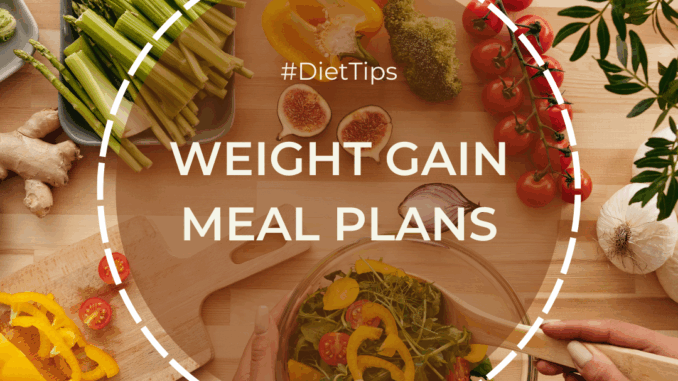
How to Gain Weight: Healthy Nutrition Tips
Gaining weight can be just as challenging as losing it. For many people, achieving a healthy weight is not about cutting calories but about consuming more in a balanced and nutritious way. The key is to focus on healthy weight gain, which means building muscle and increasing body mass without relying on junk food that can harm your long-term health. The fundamental principle of weight gain is creating a calorie surplus. This means consistently consuming more calories than your body burns each day. However, the quality of those calories is what determines whether the weight gain is healthy.
Here are the corrected and expanded nutrition tips for healthy weight gain:
1. Focus on Nutrient-Dense, Calorie-Rich Foods
Don’t just eat more; eat smarter. The goal is to maximize calories while providing your body with essential nutrients for muscle growth and overall health.
- Healthy Fats: Fats are the most calorie-dense macronutrient. Incorporate sources of healthy fats like avocados, nuts, seeds, and olive oil. Add a handful of almonds to your yogurt, slice avocado onto your toast, or drizzle olive oil over your vegetables.
- Complex Carbohydrates: These provide sustained energy and are crucial for fueling workouts and recovery. Good sources include oats, brown rice, quinoa, whole-grain breads, and starchy vegetables like potatoes and sweet potatoes.
- High-Quality Protein: Protein is essential for building and repairing muscle tissue. Aim for a protein source with every meal and snack.10 Excellent options include lean meats (chicken, fish, lean beef), eggs, dairy (milk, Greek yogurt, cottage cheese), and plant-based proteins (beans, lentils, tofu).
2. Increase Meal and Snack Frequency
The strategy of eating more frequently is a powerful tool for healthy weight gain because it tackles one of the most common hurdles: a low appetite. Instead of forcing yourself to consume large, daunting portions, you can break down your daily calorie goal into smaller, more manageable increments. This approach not only makes the process more comfortable but also provides a continuous supply of energy and nutrients to your body, which is crucial for muscle repair and growth.
Think of your body’s energy system not as a single gas tank to be filled three times a day, but as a series of smaller tanks that need regular top-ups. By consistently refueling, you prevent the energy dips that can lead to cravings for unhealthy, processed foods. This sustained nutrient intake keeps your metabolism humming and ensures your body has the building blocks it needs for new tissue.
Putting It into Practice: A Sample Daily Schedule

To make this strategy actionable, consider creating a simple schedule for yourself. You don’t need to be a rigid meal planner, but having a rough idea of when you’ll eat can make it a habit rather than a chore.
- 7:00 AM – Breakfast: Start your day strong with a substantial meal. Instead of a simple bowl of cereal, try a higher-calorie option like oatmeal made with full-fat milk and topped with nuts, seeds, and dried fruit.
- 10:00 AM – Mid-Morning Snack: This is a perfect time for a quick, calorie-dense snack. A handful of almonds and a piece of fruit, a protein bar, or a small container of cottage cheese are all excellent choices. This snack prevents you from becoming overly hungry before lunch, which could lead to overeating or poor food choices later.
- 1:00 PM – Lunch: Your midday meal should be well-balanced and hearty. A sandwich on whole-grain bread with a generous amount of lean protein and avocado, or a large salad with chickpeas, cheese, and a full-fat dressing can add significant calories.
- 4:00 PM – Afternoon Snack: This snack is critical for providing energy for an afternoon workout or preventing a slump. A Greek yogurt parfait with granola and berries, or a simple protein shake with milk and a scoop of peanut butter are great options.
- 7:00 PM – Dinner: Make dinner a satisfying and complete meal. Think lean protein, a large portion of complex carbohydrates like quinoa or sweet potatoes, and plenty of vegetables cooked with healthy oils.
- 9:00 PM – Pre-Bedtime Snack (Optional): If you’re still struggling to meet your calorie goals, a small snack before bed can be very effective. A glass of whole milk, a bowl of cottage cheese, or a spoonful of nut butter can provide slow-digesting nutrients that aid muscle recovery while you sleep.
ALSO READ Hack Your Habit: The Lazy Person’s Guide to Staying Fit (Even in Nigeria!)
The Psychological Benefit
Beyond the physical advantages, frequent eating also has a significant psychological benefit. It reframes the challenge of weight gain from an overwhelming task to a series of small, achievable victories. Each time you have a planned snack or meal, you are actively working towards your goal. This regular positive reinforcement can help maintain motivation and consistency, which are the true drivers of long-term success.
Eating three large meals a day can be overwhelming if you have a small appetite. Instead, try to eat smaller, more frequent meals and snacks every 3-4 hours. This helps you consume more calories throughout the day without feeling overly full.
- Breakfast: Start your day with a substantial, calorie-dense breakfast. Think a bowl of oatmeal with nuts and dried fruit, or scrambled eggs with whole-grain toast and avocado.
- Snacks: Plan for 2-3 nutritious snacks between meals.14 Good ideas include a handful of trail mix, an apple with peanut butter, a Greek yogurt parfait, or a protein shake.
3. Drink Your Calories
Liquids can be a great way to add calories without making you feel too full to eat solid food.

- Homemade Smoothies: Blend a combination of protein (Greek yogurt, protein powder), healthy fats (nut butter, avocado), complex carbs (oats, banana), and other nutrient-rich ingredients (spinach, berries).
- Milk: Full-fat milk is a simple and effective way to add calories and protein to your diet. Use it in smoothies, with cereal, or as a standalone drink.
4. Strategically Increase Portion Sizes
Instead of drastically increasing your food intake all at once, make small, manageable adjustments to your normal meals.
- Add an extra spoonful of rice or pasta.
- Use a larger plate to help you serve slightly bigger portions.
- Add calorie-dense toppings to your meals, such as a sprinkle of cheese on your soup or a scoop of sour cream on your baked potato.
5. Don’t Skip Meals
Consistency is key. Gaining weight is a gradual process that requires a sustained calorie surplus. Skipping meals, even one, can make it difficult to reach your daily calorie goal.
6. Incorporate Healthy “Add-ins”
Look for opportunities to boost the calorie and nutrient content of your favorite foods.
- Add powdered milk to sauces, soups, and casseroles.
- Stir nut butter into oatmeal or yogurt.
- Top salads with cheese, nuts, seeds, and a generous amount of dressing.
- Cook with healthy oils like olive oil or coconut oil.
7. Pair Nutrition with Strength Training
To ensure that the weight you’re gaining is muscle, not just fat, incorporate a regular strength training routine. Lifting weights stimulates muscle growth and helps your body use the extra calories and protein for building lean mass. Exercise also helps to stimulate your appetite, making it easier to consume more food.
What to Avoid:
- Empty Calories: Steer clear of junk food like sugary drinks, candy, and fast food.25 While they are high in calories, they lack the essential nutrients your body needs to gain weight healthily and can lead to a host of other health problems.
- Overly Relying on Supplements: While protein powders and mass gainers can be useful, your primary focus should be on getting calories and nutrients from whole foods. Supplements should be used to complement, not replace, a balanced diet.
By following these healthy nutrition tips and focusing on a consistent calorie surplus with nutrient-dense foods, you can achieve your weight gain goals effectively and safely.

Leave a Reply